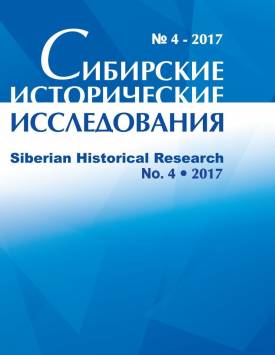On the history of the Tomsk variant of the Siberian chronicle's Naryshkin edition
The paper endeavours to establish the protograph of the Tomsk variant of the Naryshkin edition of the Siberian Chronicle, with the Naryshkin edition being the most popular in the manuscript tradition. The issue has never been raised in historiography, where, starting with the works of N. A. Dvoretskaya, who established this type of the source and whose conclusions were only repeated later, historians merely proceeded from the manuscripts of the Tomsk variant without noticing the differences between the two groups of these, with the first one represented by the Pogodin and Ivanov manuscripts, and the second - by the Zabelin and Karamzin manuscripts. The sources of the current research are the Major variant and the Tomsk variant of the Naryshkin edition of the Siberian Chronicle (the first of these variants has never been seen as separate by chroniclers before). The research methodology is based on the parallel comparison of the closing entries of the Tomsk variant and the subsequent entries of the Major variant (at the turn of the XVII to the XVIII centuries). Referring to the Academic and Viktorov manuscripts of the Major variant of the Siberian Chronicle's Naryshkin edition which contain descriptions of the same events revealing interest in the history of Tomsk as in the Tomsk variant for the years 1699-1707 (e.g., on the rotation of low-rank officials under voivodes G.M. and L.G. Petrovo-Solovovo, introduction of new taxation on land allocation and fishing, military campaigns against the Kirghiz, and foundation of the Abakan settlement (ostrog)), proves that the Tomsk variant and the Major variant in the above-cited manuscripts are derived from the same chronicle source that may have been created in the early XVIII century, no later than in 1709. This source must have originated in the Tomsk administration department, as the anonymous chronicler obviously used a voivode report on the number of the Kirghiz killed or taken hostage and established the chronology of Tomsk low-rank officials' service as well as the number of military people employed to build the Abakan settlement. Consequently, the Tomsk variant of the Siberian Chronicle's Naryshkin edition should not be regarded as an independent and standalone piece of work, for similarly to the continued Major variant drawing on the two above-mentioned manuscripts, it is based on an earlier chronicle being evidently of Tomsk origin. These findings help significantly specify the currently existing historiographic views on how writing Siberian chronicles evolved under Peter I.
Keywords
Сибирский летописный свод, Нарышкинская редакция Сибирского летописного свода, Основной вид и Томский вид Сибирского летописного свода, летописные известия по истории Томска XVII - начала XVIII в, место и время возникновения протографа Томского вида Сибирского летописного свода, Siberian Chronicle Code, Naryshkin edition of the Siberian Chronicle Code, Major and Tomsk variants of the Siberian Chronicle Code, chronicle news on the history of Tomsk in XVII - early XVIII cc, protograph of the Tomsk variant of the Siberian Chronicle CodeAuthors
| Name | Organization | |
| Solodkin Yankel G. | Nizhnevartovsk State University | hist2@yandex.ru |
References

On the history of the Tomsk variant of the Siberian chronicle's Naryshkin edition | Sibirskie Istoricheskie Issledovaniia – Siberian Historical Research. 2017. № 4. DOI: 10.17223/2312461X/18/5
